Madeleine Dietz. Schatten der wahren Vergangenheit
13 May to 17 June 2017 ⟶ Corneliusstraße
Exhibition View
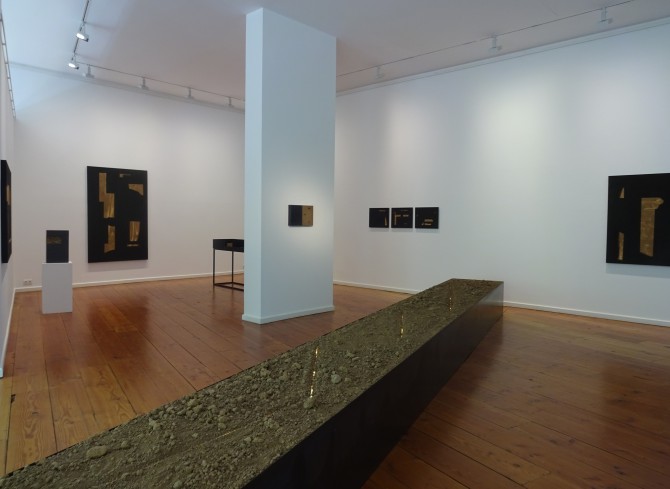
Exhibition View
ARIHA (Syria), 2017, earth/pigment on canvas, 120 x 200 cm
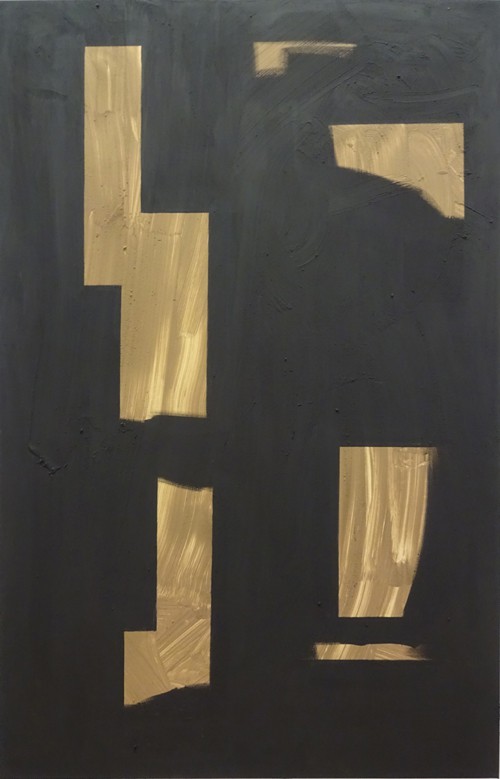
ARIHA (Syria), 2017, earth/pigment on canvas, 120 x 200 cm
Floor work in the foreground:
Credo 2014, steel/earth/lighting, 50 x 800 x 80 cm
Credo 2014, steel/earth/lighting, 50 x 800 x 80 cm
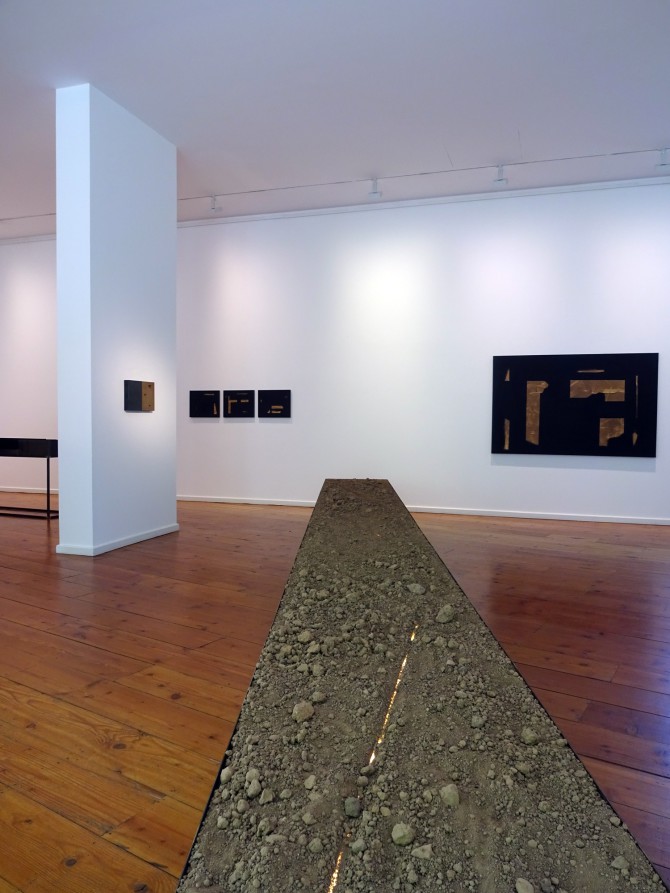
Floor work in the foreground:
Credo 2014, steel/earth/lighting, 50 x 800 x 80 cm
Credo 2014, steel/earth/lighting, 50 x 800 x 80 cm
YIRKA 2017 (Israel), 2017, earth/pigment on canvas, 120 x 200 cm
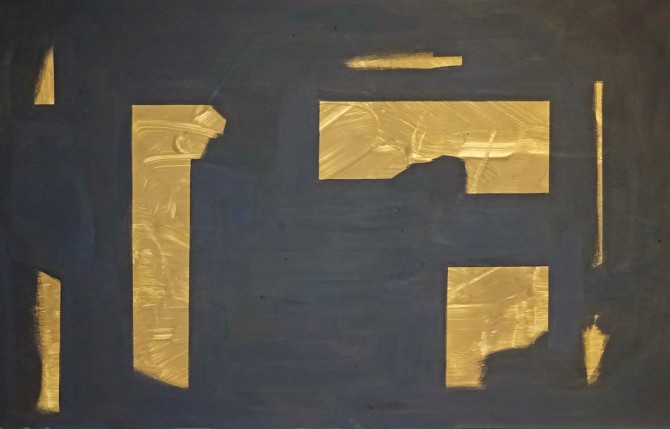
YIRKA 2017 (Israel), 2017, earth/pigment on canvas, 120 x 200 cm
Exhibition View
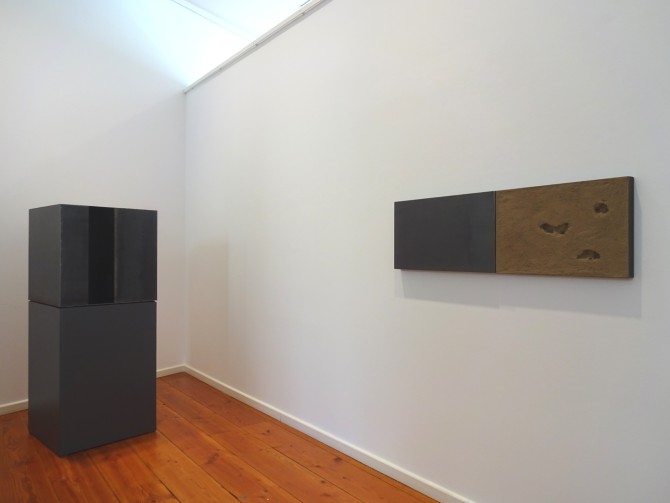
Exhibition View
No Window to Heaven, 2008, steel/earth, 70 x 70 x 70 cm
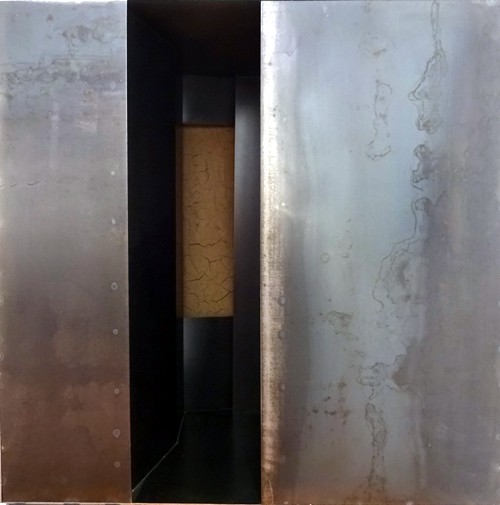
No Window to Heaven, 2008, steel/earth, 70 x 70 x 70 cm
Untitled (Relief), Feb 2014, steel/earth, 40 x 130 x 5 cm
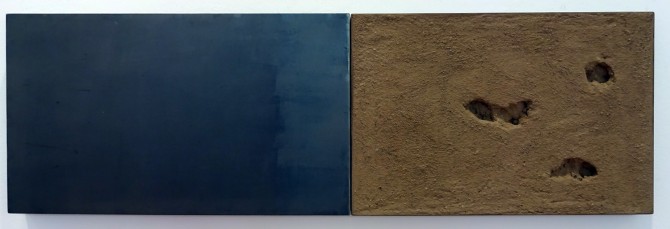
Untitled (Relief), Feb 2014, steel/earth, 40 x 130 x 5 cm
Partial view of the exhibition
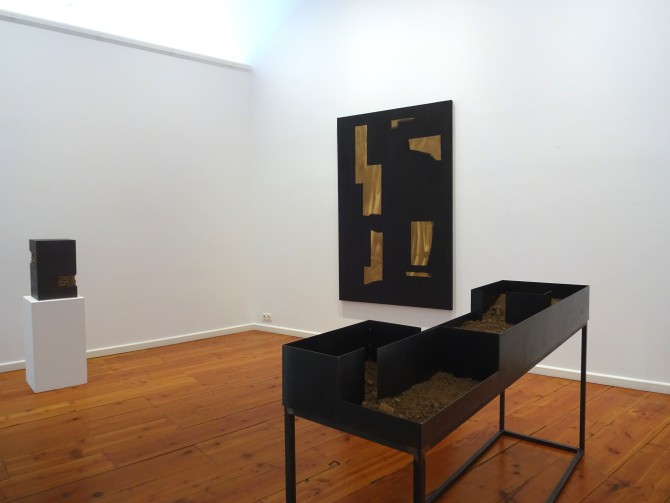
Partial view of the exhibition
WHAT WAS ABOVE WILL BE BELOW..., 2006, steel/earth, 30 x 50 x 200 cm (with steel base)
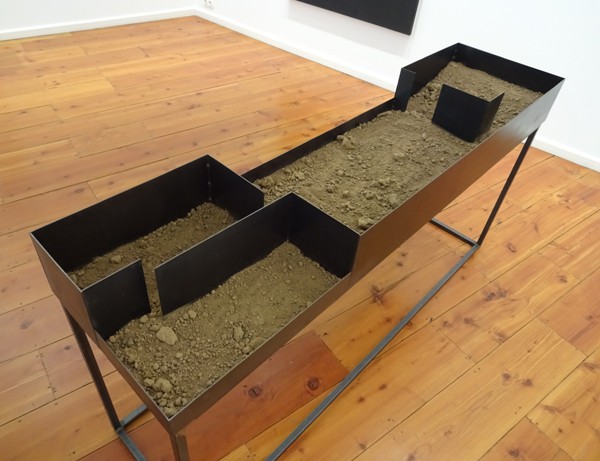
WHAT WAS ABOVE WILL BE BELOW..., 2006, steel/earth, 30 x 50 x 200 cm (with steel base)
Safe, November 2015, steel/dried earth, 50 x 35 x 35 cm
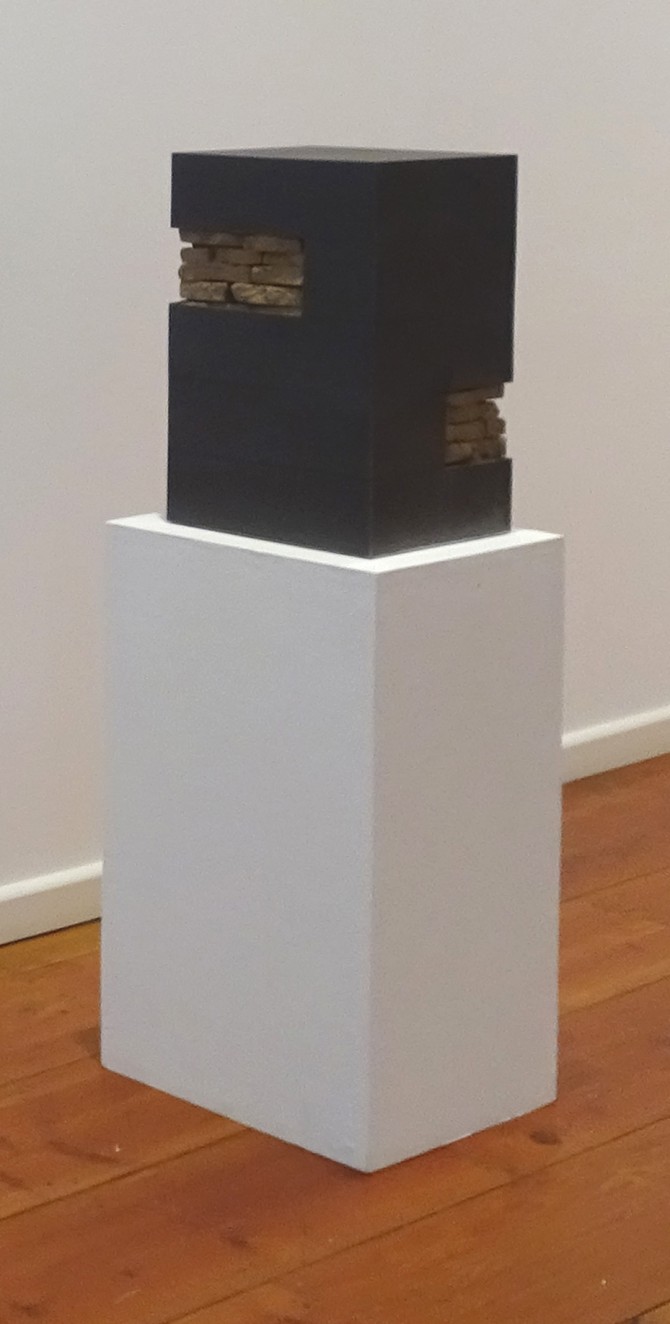
Safe, November 2015, steel/dried earth, 50 x 35 x 35 cm
Exhibition View
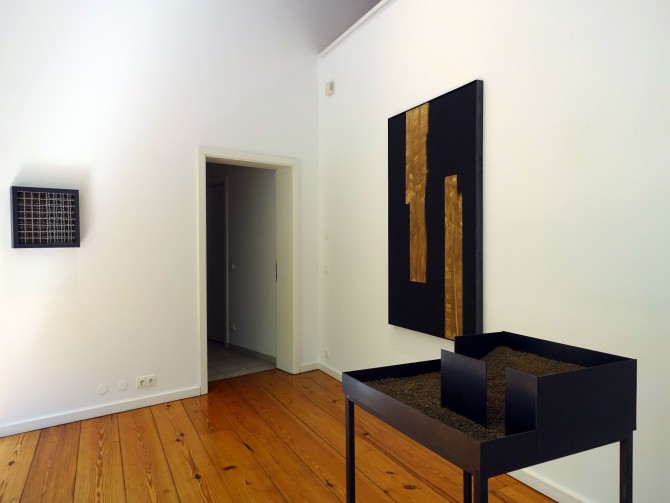
Exhibition View
WHAT WAS ABOVE WILL BE BELOW No. 7, 2004, steel/earth, 20 x 70 x 90 cm (with plinth)
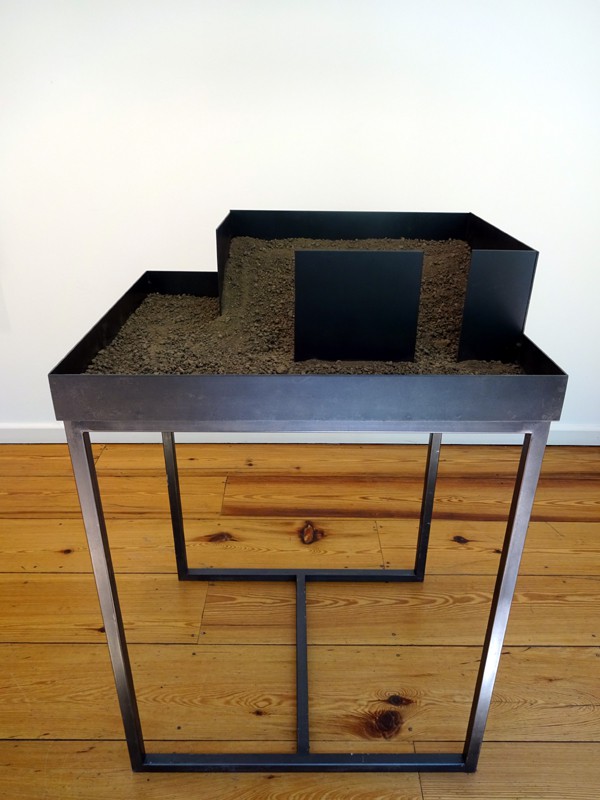
WHAT WAS ABOVE WILL BE BELOW No. 7, 2004, steel/earth, 20 x 70 x 90 cm (with plinth)
No Rose Grove, 2015, steel/earth/grid, 42 x 42 x 10 cm
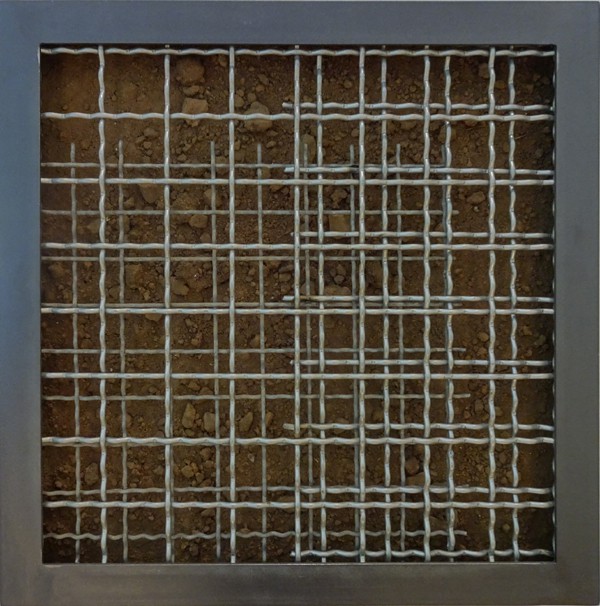
No Rose Grove, 2015, steel/earth/grid, 42 x 42 x 10 cm
Exhibition View
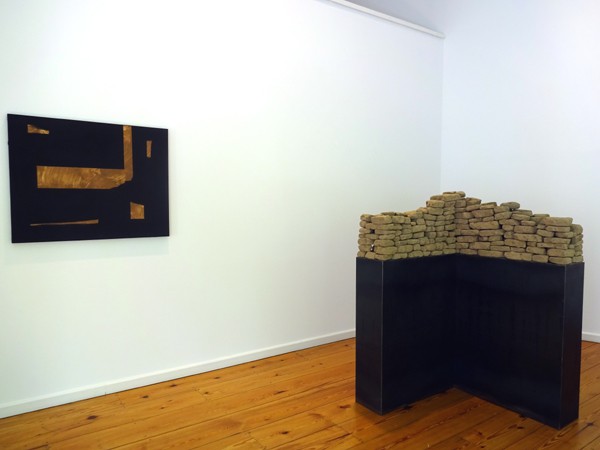
Exhibition View
Installations and fragmentary tracings
The viewer looks at a cube in the format 40x40x40 cm or also 70x70x70cm, which bears the model-like as a characteristic in itself, because the cubes would also be conceivable as large steel-earth rooms. First and foremost, one sees steel, which at various points opens up lines of sight that then allow one to perceive dried earth surfaces inside the object. It quickly becomes clear that no overall perspective can be established from these objects, and not only because parts of the work are hidden inside in a way that cannot be opened up, like a secret in a treasure chest or a safe. What is this space that the ore encloses? We could calculate its volume, reconstruct it in 3D, describe it physically, circle it phenomenologically, but that would not give us its truth, which is only revealed in aesthetic experience. These cubes of space want to be experienced physically, and that is precisely because it is not possible, because there always remains a residue of the physically inexperienced. They are not meta-physical objects, however, but aesthetic offers of spatial perception. Their treasure does not lie in them, but is revealed in their experience. The new painterly works by Madeleine Dietz bear titles such as Meggido, Hazor, Herat or Kunar and thus initially trigger a wealth of memories, associations and connotations. We think of the early history of the Near East, of Israel and Afghanistan, perhaps even of Bactria, and we are reminded of the history of human civilisation 6,000 years ago, the time of sedentarisation, but also of the apocalyptic events that some traditions associate with the plain of Meggido under the keyword "Armageddon", where the last battle of humanity is to take place. These memories and associations are not coincidental, but have been deliberately evoked by the artist, for in her works she connects the "shadows of the true past" thus conjured up with the here and now of a time in which these memories are becoming a point of contention between cultures and are subject to symbolic destruction and no longer merely natural weathering processes. In an almost literal sense, therefore, it is about tracing our cultural history, about a memento (Remember!) and about punctuation. In a material sense, the pictures are layers in time, they are an archaeology of human experiences and homes. It is about the dwelling places and cities of people thousands of years ago, which have long since perished and have been painstakingly excavated stone by stone, layer by layer for several decades. Madeleine Dietz visualises this process in a new artistic act that sensitises our perception to the history under our feet (and before our eyes). To do this, she grounds the canvases with earth and then carefully draws into them ground plans of houses, residential districts or temple complexes, i.e. the homes of our ancestors that provided them with shelter and security. These memories of vanished human civilisations - shadows of the true past - are then reworked, alienated, destroyed, overlaid with new layers and painted over until finally the picture emerges that is now before the viewers' eyes. And thus, in the contemplation of the images, we become what the Greek Nobel Prize winner for literature Giorgos Seferis describes in his book of poems "Mythical Life Report" (mythistorema): We are "wanderers among broken stones for three or six thousand years, pokers in cracked structure that would easily be our own house". The artist's memory thus set in motion results in an independent image, almost in the sense of informal art, which was also - let us only think of Antoni Tàpies - borne by grounding and sign-making. Madeleine Dietz's artworks are on the one hand determined by an "aesthetics of decay" and on the other hand concrete interventions in the political processes of the present. For Meggido, Hazor, Herat or Kunar are not only sites of remembrance, but also settings for today's conflicts. The shadows of the real past still challenge. (Text: Andreas Mertin)
The viewer looks at a cube in the format 40x40x40 cm or also 70x70x70cm, which bears the model-like as a characteristic in itself, because the cubes would also be conceivable as large steel-earth rooms. First and foremost, one sees steel, which at various points opens up lines of sight that then allow one to perceive dried earth surfaces inside the object. It quickly becomes clear that no overall perspective can be established from these objects, and not only because parts of the work are hidden inside in a way that cannot be opened up, like a secret in a treasure chest or a safe. What is this space that the ore encloses? We could calculate its volume, reconstruct it in 3D, describe it physically, circle it phenomenologically, but that would not give us its truth, which is only revealed in aesthetic experience. These cubes of space want to be experienced physically, and that is precisely because it is not possible, because there always remains a residue of the physically inexperienced. They are not meta-physical objects, however, but aesthetic offers of spatial perception. Their treasure does not lie in them, but is revealed in their experience. The new painterly works by Madeleine Dietz bear titles such as Meggido, Hazor, Herat or Kunar and thus initially trigger a wealth of memories, associations and connotations. We think of the early history of the Near East, of Israel and Afghanistan, perhaps even of Bactria, and we are reminded of the history of human civilisation 6,000 years ago, the time of sedentarisation, but also of the apocalyptic events that some traditions associate with the plain of Meggido under the keyword "Armageddon", where the last battle of humanity is to take place. These memories and associations are not coincidental, but have been deliberately evoked by the artist, for in her works she connects the "shadows of the true past" thus conjured up with the here and now of a time in which these memories are becoming a point of contention between cultures and are subject to symbolic destruction and no longer merely natural weathering processes. In an almost literal sense, therefore, it is about tracing our cultural history, about a memento (Remember!) and about punctuation. In a material sense, the pictures are layers in time, they are an archaeology of human experiences and homes. It is about the dwelling places and cities of people thousands of years ago, which have long since perished and have been painstakingly excavated stone by stone, layer by layer for several decades. Madeleine Dietz visualises this process in a new artistic act that sensitises our perception to the history under our feet (and before our eyes). To do this, she grounds the canvases with earth and then carefully draws into them ground plans of houses, residential districts or temple complexes, i.e. the homes of our ancestors that provided them with shelter and security. These memories of vanished human civilisations - shadows of the true past - are then reworked, alienated, destroyed, overlaid with new layers and painted over until finally the picture emerges that is now before the viewers' eyes. And thus, in the contemplation of the images, we become what the Greek Nobel Prize winner for literature Giorgos Seferis describes in his book of poems "Mythical Life Report" (mythistorema): We are "wanderers among broken stones for three or six thousand years, pokers in cracked structure that would easily be our own house". The artist's memory thus set in motion results in an independent image, almost in the sense of informal art, which was also - let us only think of Antoni Tàpies - borne by grounding and sign-making. Madeleine Dietz's artworks are on the one hand determined by an "aesthetics of decay" and on the other hand concrete interventions in the political processes of the present. For Meggido, Hazor, Herat or Kunar are not only sites of remembrance, but also settings for today's conflicts. The shadows of the real past still challenge. (Text: Andreas Mertin)